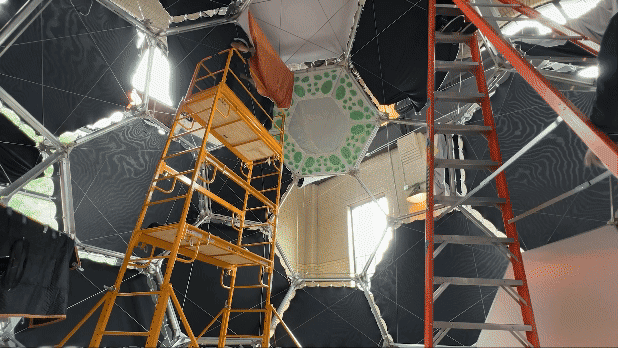Introducing the TESSERAE Space Habitat Pavilion
Our full-scale space habitat model will be exhibited at the Seattle Museum of Flight this fall
Visitors to the TESSERAE Space Habitat Pavilion
The Aurelia team has been hard at work this summer bringing to life our most ambitious project yet: the public debut of our TESSERAE Space Habitat Pavilion, which will be on exhibit at Seattle’s Museum of Flight this fall!
The Pavilion has been in the works for two years, and in past newsletters we’ve shared our progress in designing and building the structure and its interior components. Now for the first time the team has built the complete Pavilion, outside and in, with never-before-seen structural components and interior tiles, realizing Aurelia’s vision of an interactive exhibition that brings the future of space habitats down to Earth for all to explore.
"What would it take to design, very intentionally, a different type of space in space? A different type of habitat that's way more welcoming and engaging to a broader swath of humanity?” Ariel Ekblaw says in a Dezeen feature on the TESSERAE concept. "Democratizing access to space means we have to design for that."
We soft-launched the TESSERAE Space Habitat Pavilion as part of ISSRDC 2024, where Ekblaw gave a talk on Aurelia’s mission to scale up life in space. Over the course of two weeks at The Substation in Roslindale, we had the remarkable opportunity of inviting scientists, researchers, designers, and school groups to visit the Pavilion, answer their questions, and see their reactions to the experience.
With this successful short-run exhibit under our belts, we are thrilled to bring the TESSERAE Pavilion to the Museum of Flight in Seattle this fall! As part of the museum’s Home Beyond Earth exhibit, the Pavilion will join over fifty artifacts, models, and space-flown objects (including our own TESSERAE tiles) in an in-depth exploration of humanity’s past, present, and future of habitats and communities in space.
The TESSERAE Pavilion will open to the public on September 28 and run through the exhibit’s close in January, 2025. We hope you’ll check it out!
Get to know the TESSERAE Pavilion
As work continues on the TESSERAE self-assembling tiles (read the latest in MIT Technology Review), the Pavilion offers a tactile, experiential way to open a dialogue on human-centered design in space.
When TESSERAE habitats launch into LEO in years to come, they will be modular and serve a range of people and needs. The Pavilion focuses on one particular vision for near-future space habitats: living spaces centered on well-being. This iteration of the Pavilion is centered on the theme of exploring culture and community in space through growing, cooking and eating in microgravity.
Within its 19x24-foot area, you will find a series of functional tiles mounted into the structure and human-centered concept elements incorporated into the interior, each designed to support the needs and well-being of space inhabitants.
TESSERAE kitchen panel
A full hexagon panel outfitted with several different kitchen features:
The Green Vault: a microgravity-compatible and fully functional aeroponics green wall, testing how to grow fresh produce for nutrition and mental health.
Surrounding the Green Vault are two pantry tiles, using nature-inspired patterns of phyllotaxis (like in sunflowers) to produce elegant, tight spaces where food and other preparation materials can be tucked in and securely stored.
Fermentation Station: multiple fermentation orbs with controllable thermal plates and gas exchange for guiding the fermentation process for foods like sourdough, kimchi, miso, and more.
H0tP0t: a sous-vide-style boiler designed by Harvard researcher Larissa Zhou to reimagine cooking in microgravity. (Learn more in a recent feature in Scientific American.)
TESSERAE algae “stained-glass” window
This multi-chamber window posits a future where oxygen-producing algae can be used as part of habitat life support systems to generate breathable air. We hope to show that safe, functional habitat elements can also delight and inspire future spacefarers by invoking the sublime beauty of rose windows on Earth.
TESSERAE way-finding and ergonomics
Sea anemone-inspired inflatables and a hand-knotted net (building on traditions from sea-faring societies) provide ways to support guided movement and relaxation in a large open volume. Navigating microgravity spaces requires special considerations for hand-holds and rest areas, to help crew members control their floating motion and proprioception (awareness of their body position, orientation, and movement).






